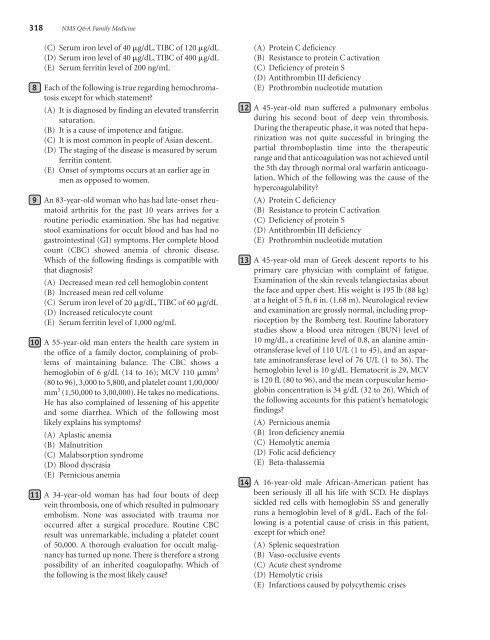NMS Q&A Family Medicine
NMS Q&A Family Medicine
NMS Q&A Family Medicine
- No tags were found...
You also want an ePaper? Increase the reach of your titles
YUMPU automatically turns print PDFs into web optimized ePapers that Google loves.
318 <strong>NMS</strong> Q&A <strong>Family</strong> <strong>Medicine</strong>(C) Serum iron level of 40 g/dL, TIBC of 120 g/dL(D) Serum iron level of 40 g/dL, TIBC of 400 g/dL(E) Serum ferritin level of 200 ng/mL8 Each of the following is true regarding hemochromatosisexcept for which statement?(A) It is diagnosed by finding an elevated transferrinsaturation.(B) It is a cause of impotence and fatigue.(C) It is most common in people of Asian descent.(D) The staging of the disease is measured by serumferritin content.(E) Onset of symptoms occurs at an earlier age inmen as opposed to women.9 An 83-year-old woman who has had late-onset rheumatoidarthritis for the past 10 years arrives for aroutine periodic examination. She has had negativestool examinations for occult blood and has had nogastrointestinal (GI) symptoms. Her complete bloodcount (CBC) showed anemia of chronic disease.Which of the following findings is compatible withthat diagnosis?(A) Decreased mean red cell hemoglobin content(B) Increased mean red cell volume(C) Serum iron level of 20 g/dL, TIBC of 60 g/dL(D) Increased reticulocyte count(E) Serum ferritin level of 1,000 ng/mL10 A 55-year-old man enters the health care system inthe office of a family doctor, complaining of problemsof maintaining balance. The CBC shows a3hemoglobin of 6 g/dL (14 to 16); MCV 110 mm(80 to 96), 3,000 to 5,800, and platelet count 1,00,000/mm 3 (1,50,000 to 3,00,000). He takes no medications.He has also complained of lessening of his appetiteand some diarrhea. Which of the following mostlikely explains his symptoms?(A) Aplastic anemia(B) Malnutrition(C) Malabsorption syndrome(D) Blood dyscrasia(E) Pernicious anemia11 A 34-year-old woman has had four bouts of deepvein thrombosis, one of which resulted in pulmonaryembolism. None was associated with trauma noroccurred after a surgical procedure. Routine CBCresult was unremarkable, including a platelet countof 50,000. A thorough evaluation for occult malignancyhas turned up none. There is therefore a strongpossibility of an inherited coagulopathy. Which ofthe following is the most likely cause?(A) Protein C deficiency(B) Resistance to protein C activation(C) Deficiency of protein S(D) Antithrombin III deficiency(E) Prothrombin nucleotide mutation12 A 45-year-old man suffered a pulmonary embolusduring his second bout of deep vein thrombosis.During the therapeutic phase, it was noted that heparinizationwas not quite successful in bringing thepartial thromboplastin time into the therapeuticrange and that anticoagulation was not achieved untilthe 5th day through normal oral warfarin anticoagulation.Which of the following was the cause of thehypercoagulability?(A) Protein C deficiency(B) Resistance to protein C activation(C) Deficiency of protein S(D) Antithrombin III deficiency(E) Prothrombin nucleotide mutation13 A 45-year-old man of Greek descent reports to hisprimary care physician with complaint of fatigue.Examination of the skin reveals telangiectasias aboutthe face and upper chest. His weight is 195 lb (88 kg)at a height of 5 ft, 6 in. (1.68 m). Neurological reviewand examination are grossly normal, including proprioceptionby the Romberg test. Routine laboratorystudies show a blood urea nitrogen (BUN) level of10 mg/dL, a creatinine level of 0.8, an alanine aminotransferaselevel of 110 U/L (1 to 45), and an aspartateaminotransferase level of 76 U/L (1 to 36). Thehemoglobin level is 10 g/dL. Hematocrit is 29, MCVis 120 fL (80 to 96), and the mean corpuscular hemoglobinconcentration is 34 g/dL (32 to 26). Which ofthe following accounts for this patient’s hematologicfindings?(A) Pernicious anemia(B) Iron deficiency anemia(C) Hemolytic anemia(D) Folic acid deficiency(E) Beta-thalassemia14 A 16-year-old male African-American patient hasbeen seriously ill all his life with SCD. He displayssickled red cells with hemoglobin SS and generallyruns a hemoglobin level of 8 g/dL. Each of the followingis a potential cause of crisis in this patient,except for which one?(A) Splenic sequestration(B) Vaso-occlusive events(C) Acute chest syndrome(D) Hemolytic crisis(E) Infarctions caused by polycythemic crises
















